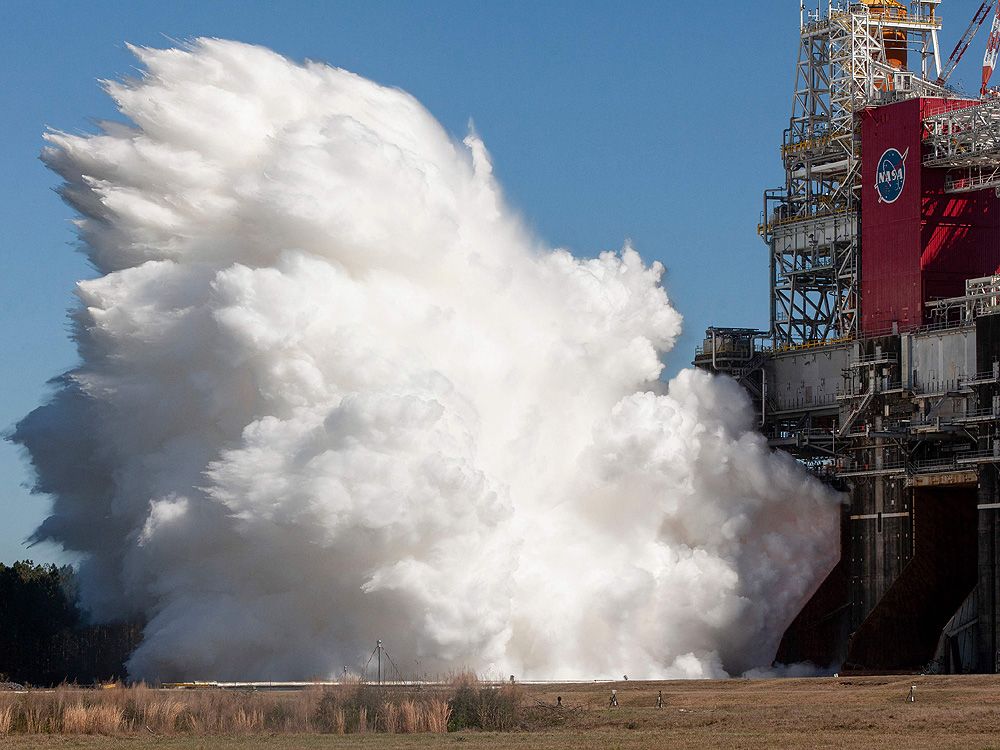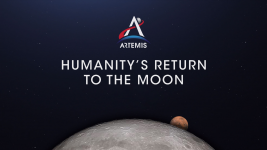NASA completes major test on rocket that could take humans back to moon
Author of the article:Reuters
Reuters
Publishing date:Mar 18, 2021 • 1 day ago • 1 minute read • comment bubbleJoin the conversation
This handout photo courtesy of NASA shows the core stage for the first flight of NASAs Space Launch System rocket in the B-2 Test Stand during a second hot fire test on March 18, 2021, at NASAs Stennis Space Center near Bay St. Louis, Mississippi.
The second "hot fire" test saw all four of the rocket's RS-25 engines fire simultaneously at 4:40 pm Eastern time (1940 GMT) for the full duration of eight minutes, producing a maximum of 1.6 million pounds of thrust (7.1 million newtons). (Photo by Robert MARKOWITZ / NASA / AFP) / RESTRICTED TO EDITORIAL USE - MANDATORY CREDIT "AFP PHOTO / Robert MARKOWITZ / NASA " - NO MARKETING - NO ADVERTISING CAMPAIGNS - DISTRIBUTED AS A SERVICE TO CLIENTS (Photo by ROBERT MARKOWITZ/NASA/AFP via Getty Images)
This handout photo courtesy of NASA shows the core stage for the first flight of NASAs Space Launch System rocket in the B-2 Test Stand during a second hot fire test on March 18, 2021, at NASAs Stennis Space Center near Bay St. Louis, Mississippi. The second "hot fire" test saw all four of the rocket's RS-25 engines fire simultaneously at 4:40 pm Eastern time (1940 GMT) for the full duration of eight minutes, producing a maximum of 1.6 million pounds of thrust (7.1 million newtons). (Photo by Robert MARKOWITZ / NASA / AFP) / RESTRICTED TO EDITORIAL USE - MANDATORY CREDIT "AFP PHOTO / Robert MARKOWITZ / NASA " - NO MARKETING - NO ADVERTISING CAMPAIGNS - DISTRIBUTED AS A SERVICE TO CLIENTS (Photo by ROBERT MARKOWITZ/NASA/AFP via Getty Images) PHOTO BY ROBERT MARKOWITZ/NASA /AFP via Getty Images
Article content
Aerospace firms on Thursday credited NASA with a successful test of engines on a Boeing-built rocket for Artemis missions that aim to return U.S. astronauts to the moon by 2024, more than half a century since the last lunar walk.
NASA simulated a launch by firing the engines of the core stage of the Space Launch System (SLS) rocket while it was anchored to a tower at its Stennis Space Center in Mississippi.
The four RS-25 engines roared to life for the full eight minutes of the test and filled the surrounding area and sky with clouds of white smoke. After the engines cut off, NASA employees could be heard applauding on the space agency’s live-streaming video, and many aerospace firms publicly congratulated NASA on a successful test.
A previous test in January ended after about a minute – well short of the roughly four minutes engineers needed to gather enough data.
The Space Launch System is now expected to go to the Kennedy Space Center in Florida for integration with Lockheed Martin Corp’s Orion spacecraft.
Advertisement
STORY CONTINUES BELOW
This advertisement has not loaded yet, but your article continues below.
Article content
NASA aims to send an uncrewed spacecraft to orbit the moon in November and return U.S. astronauts to the moon by 2024, but the SLS program is three years behind schedule and nearly $3 billion over budget.
President Joe Biden has tapped former Democratic senator and astronaut Bill Nelson to run the U.S. space agency, according to two people familiar with the decision.
It was a much-sought-after victory for Boeing after multiple setbacks.
Boeing lost a race for its Starliner crew capsule to be the first to carry astronauts from U.S. soil to the International Space Station in nearly a decade to Elon Musk’s SpaceX.
Jeff Bezos’ Blue Origin is also racing to send its own crewed mission to space for the first time.


 torontosun.com
torontosun.com
Author of the article:Reuters
Reuters
Publishing date:Mar 18, 2021 • 1 day ago • 1 minute read • comment bubbleJoin the conversation
This handout photo courtesy of NASA shows the core stage for the first flight of NASAs Space Launch System rocket in the B-2 Test Stand during a second hot fire test on March 18, 2021, at NASAs Stennis Space Center near Bay St. Louis, Mississippi.
The second "hot fire" test saw all four of the rocket's RS-25 engines fire simultaneously at 4:40 pm Eastern time (1940 GMT) for the full duration of eight minutes, producing a maximum of 1.6 million pounds of thrust (7.1 million newtons). (Photo by Robert MARKOWITZ / NASA / AFP) / RESTRICTED TO EDITORIAL USE - MANDATORY CREDIT "AFP PHOTO / Robert MARKOWITZ / NASA " - NO MARKETING - NO ADVERTISING CAMPAIGNS - DISTRIBUTED AS A SERVICE TO CLIENTS (Photo by ROBERT MARKOWITZ/NASA/AFP via Getty Images)
This handout photo courtesy of NASA shows the core stage for the first flight of NASAs Space Launch System rocket in the B-2 Test Stand during a second hot fire test on March 18, 2021, at NASAs Stennis Space Center near Bay St. Louis, Mississippi. The second "hot fire" test saw all four of the rocket's RS-25 engines fire simultaneously at 4:40 pm Eastern time (1940 GMT) for the full duration of eight minutes, producing a maximum of 1.6 million pounds of thrust (7.1 million newtons). (Photo by Robert MARKOWITZ / NASA / AFP) / RESTRICTED TO EDITORIAL USE - MANDATORY CREDIT "AFP PHOTO / Robert MARKOWITZ / NASA " - NO MARKETING - NO ADVERTISING CAMPAIGNS - DISTRIBUTED AS A SERVICE TO CLIENTS (Photo by ROBERT MARKOWITZ/NASA/AFP via Getty Images) PHOTO BY ROBERT MARKOWITZ/NASA /AFP via Getty Images
Article content
Aerospace firms on Thursday credited NASA with a successful test of engines on a Boeing-built rocket for Artemis missions that aim to return U.S. astronauts to the moon by 2024, more than half a century since the last lunar walk.
NASA simulated a launch by firing the engines of the core stage of the Space Launch System (SLS) rocket while it was anchored to a tower at its Stennis Space Center in Mississippi.
The four RS-25 engines roared to life for the full eight minutes of the test and filled the surrounding area and sky with clouds of white smoke. After the engines cut off, NASA employees could be heard applauding on the space agency’s live-streaming video, and many aerospace firms publicly congratulated NASA on a successful test.
A previous test in January ended after about a minute – well short of the roughly four minutes engineers needed to gather enough data.
The Space Launch System is now expected to go to the Kennedy Space Center in Florida for integration with Lockheed Martin Corp’s Orion spacecraft.
Advertisement
STORY CONTINUES BELOW
This advertisement has not loaded yet, but your article continues below.
Article content
NASA aims to send an uncrewed spacecraft to orbit the moon in November and return U.S. astronauts to the moon by 2024, but the SLS program is three years behind schedule and nearly $3 billion over budget.
President Joe Biden has tapped former Democratic senator and astronaut Bill Nelson to run the U.S. space agency, according to two people familiar with the decision.
It was a much-sought-after victory for Boeing after multiple setbacks.
Boeing lost a race for its Starliner crew capsule to be the first to carry astronauts from U.S. soil to the International Space Station in nearly a decade to Elon Musk’s SpaceX.
Jeff Bezos’ Blue Origin is also racing to send its own crewed mission to space for the first time.


NASA completes major test on rocket that could take humans back to moon
Aerospace firms on Thursday credited NASA with a successful test of engines on a Boeing-built rocket for Artemis missions that aim to return U.S. astronauts to the …
